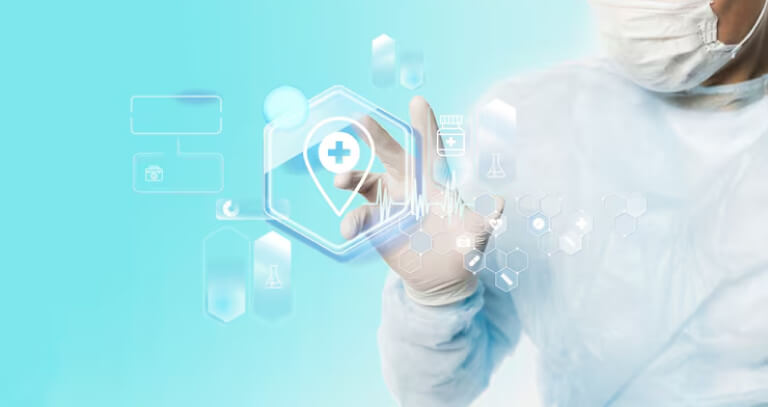Key Medical Billing Software Features to Improve Workflow
Ditstek Blogs
Medical billing software is used by healthcare businesses to manage billing and revenue cycle management operations. It helps healthcare staff to process invoices and payments, submit medical claims, and monitor the status of claims. These applications also integrate with electronic health record systems to record all bills generated throughout the patient journey, ensuring accuracy and minimizing the possibility of errors.
Most healthcare organizations use medical billing software to invoice and process bills. However, every software is different and comes with different features. Some may offer core billing features, while others come with quick claim processing. However, the requirements of different businesses vary as they require specific features to streamline their billing and related operations.
In this blog, we will explore all the features of medical billing software that healthcare businesses can consider making their billing convenient and enhance their services.
Faster Payments, Fewer Errors, Happier Patients!
Our medical billing software speeds up reimbursements, minimizes claim denials, and ensures accuracy—because financial health matters as much as patient health!
Key Medical Billing Software Features to Look For

Are you looking to get billing software for your healthcare business? To make the most out of the money you spend on software, you need to look for features you really want to streamline your billing and claim processing. Here are the essential features you should consider in a healthcare billing solution.
Billing Automation
Healthcare billing software is used to automate the invoicing workflow. This is done to minimize the manual workload for staff and allow them to focus more on offering patient care. The software can capture patient information and transfer it between departments, from user registration to claim reimbursement, without the need for manual processing.
The solution also allows rule-based invoicing using predefined rules for medical billing. Medical codes and charges are used for registered patients to ensure consistency and minimize human errors. This also improves the speed and accuracy of the billing process.
Claim Management
Your billing software should have claim management features to help you submit, organize, and track billing claims. The solution should also be able to check the accuracy of claims, which helps you to minimize rejections and denials. When you submit the claims properly, it also makes your cash flow consistent, and your admin staff gets more time to focus on patient care and their core tasks. So, it is good to look for a solution that comes with healthcare claim management features and automatic updates.
Data Security and HIPAA Compliance
Medical billing solutions must meet the HIPAA regulations. Any software that doesn't guarantee HIPAA compliance is not worth considering for healthcare services. Compliance is not limited to HIPAA, but the solution should have features like data encryption, access control, and automatic logoff for the protection of patients and the organization's data. Software that adheres to healthcare industry regulations can save your business from costly data breaches and loss of money.
It is important to review HIPAA compliance periodically to stay updated with the latest guidelines. Your software provider needs to upgrade the application to comply with changes in industry regulations.
Integration with Existing Systems
Medical billing software should work with existing systems in your organization, such as EHRs and patient engagement systems. A seamless integration with other systems ensures smooth data exchange and accuracy. It eliminates the need for manual data entries, which are prone to human errors. Reliable connectivity and integration with other systems save time and keep patient data secure. Look for integration options that are easier to implement and less disruptive.
Patient Pre-Registration
Seriously, nobody likes sitting in a waiting room, flipping through newspapers or magazines as they visit for a checkup or treatment. Pre-registration is the solution to waiting times. Patients can get their info in before they even walk in the door.
Also, the hospital knows your medical history, insurance, and every other information you give them. They know who you are and what you need and can get right to it. Pre-registration can minimize billing errors, and nobody likes surprises in the form of bills. So, check for pre-registration features while looking for medical billing software to minimize waiting times.
Payment Modes & Financial Management
As patients expect convenience in everything, they expect the same while paying bills. Patients may use a variety of methods for payments. A good billing system must accept everything like cash, credit, digital wallets, and even future-forward payment modes.
A flexible revenue cycle management system (RCM) ensures that whether payments are made at check-in or post-treatment, they are convenient for users. When financial management is deeply embedded into the healthcare ecosystem, it enhances cash flow, reduces payment delays, and improves patient trust in your brand.
Automated Accounting
Manual processes are outdated and no longer serve the present needs of healthcare organizations. A modern billing system automates everything like coding, claims processing, insurance management, and payment tracking.
Automation helps minimize the chances of errors, stops claims from being turned down, and makes payments faster than ever. Things like online billing, auto payment reminders, and watching your money in real time make billing smooth for users and healthcare providers.
Automation serves as a catalyst for medical billing operations in clinics, hospitals, pharmacies, and health insurance providers.
More Billing, Less Chilling – Automate Your Finances!
Ditch the manual errors and slow processing. Our AI-driven billing solutions keep the cash flowing while you focus on patient care.
Patient Billing Portals
Patient billing portals are websites or mobile apps like online banking for medical bills. Patients can log in to see bills and pay when it works for them. Healthcare providers can get quicker payments, fewer arguments, and steady money coming in.
Patients can see everything, including their bills paid, pending bills, and also their transaction history in a clinic or hospital. A healthcare billing software with a patient billing portal allows patients to check their bills in one place. It can be an app or a website.
Patient Database
A patient database is helpful, but it's way better when it works with EHR/EMR systems without problems. When billing software can see patient records in real-time, insurance info, prescriptions, past health issues, it stops mistakes, speeds up approvals, and brings in more money. Cloud-based options make it even easier to get to and keep safe. This means a smarter way to handle medical billing with data.
Denial Management
Claims that are turned down are awful, but they should not be left that way. Software with a feature for dealing with denied claims finds out why they were rejected, figures out the error codes, and helps you fix things.
A medical billing solution with denial management:
- Find out why claims are being turned down.
- Sort them to make it easier to deal with them.
- Make billing better, so fewer claims are denied later.
- Train staff with useful information to cut down on mistakes.
- More approvals. Less trouble. More money.
User-Friendly Interface & Customization
A simple, well-made design isn't just for looks, it's about how easy it is to use. A medical billing system should be easy to get around, with options you can change to fit healthcare staff requirements.
When a billing solution aligns with the way your staff works, they can use it easily, make fewer mistakes, and get more done in less time.
Analytics & Reporting
Numbers tell you about the progress of your day-to-day billing operations. With good ways to watch and report, healthcare staff can see how payments are going, guess how much money will come in, and find what's not working well.
Healthcare providers can see the incoming money, pending payments, and how they are doing financially in real time.
A reporting system doesn't just show problems, it helps you fix them before they hurt your profits. So, look for analytics and reporting features while searching for a medical billing solution for your organization.
Customizable Features
Customization allows you to maximize your ROI by customizing some medical billing software features as per your requirements. No two practices are the same, which makes some level of customization essential for healthcare providers. Customizable features allow you to optimize your day-to-day operations with capabilities that fit your unique needs. While searching for medical billing software, look for flexible options like automatic payment plans and payment notification options, including mail, text, etc. You can ask for demos or trials that allow you to test features before making a long-term commitment.
Custom Billing Software Designed for Healthcare Operations!
Why settle for off-the-shelf when you can have a solution built just for you? Get a medical billing system that works your way.
How can DITS Help you With a Custom Billing Software Solution?
Looking to upgrade your healthcare practice with customized billing solutions? At DITS, we develop custom healthcare software and other healthcare applications that suit your needs. We know your challenges, and our experts will develop solutions accordingly. Whether you want to integrate advanced medical billing software features or develop complete practice management software, we help healthcare companies improve efficiency, reduce costs, and focus on their main objective – patients. Get in touch with DITS to talk about our software development service for your healthcare businesses.
Conclusion
Medical billing is more than just sending bills, it’s about making a smooth money process for both healthcare providers and patients. From patient registrations to dealing with rejected claims, every part of billing brings convenience and allows healthcare providers to offer better patient care.
By using automation, being able to change things, and using data wisely, you’re not just making billing better—you’re getting ready for what’s next in healthcare.
FAQ’s
1. What is medical billing software, and why is it important?
Medical billing software is a program that helps doctors' offices handle patient billing, insurance claims, and payments. It automates things like submitting claims and following rules. This cuts down on mistakes and makes things run smoother. By working with electronic health records (EHR) and patient management systems, it makes sure billing is correct, payments come on time, and the money side of things works well for medical practices.
2. What are the key features to look for in medical billing software?
Good medical billing software should have: automated claim processing, real-time checks for insurance, EHR, patient billing and invoicing, following the rules, reports, and access for multiple users. These things are great in helping cut down on mistakes, make things faster, and make sure payments are on time. Some programs might even have AI to help automate tasks and ways to change how things are done to make billing even better.
3. How does medical billing software improve claim processing?
Medical billing software does claim submissions automatically, which means fewer mistakes and fewer claims getting denied. It checks if a patient is insured right away and points out any problems before submitting. Many systems have tools that spot mistakes, so users can fix them before submitting. This increases the chances of claims getting accepted, reduces delays, and speeds up payments for doctors.
4. Can medical billing software integrate with existing healthcare systems?
Yes, new medical billing software is made to work with EHRs, practice management systems, and accounting tools without any problems. This lets information flow easily, stops entering the same information twice, and makes work run smoother. By connecting billing with patient records and money management, doctors can be more accurate and make the office run more smoothly.
5. What should healthcare providers consider when choosing medical billing software?
When picking medical billing software, doctors should think about things like how easy it is to use, if it can grow with the practice, if it can connect to other systems, if it follows the rules, what kind of customer support they offer, and how much it costs. It's important to pick something that fits what the practice needs, helps automate tasks, and keeps data safe. Trying it out for free can help you see if it fits before making a decision.

Nidhi Thakur
With more than 19 years of experience - I represent a team of professionals that specializes in the healthcare and business and workflow automation domains. The team consists of experienced full-stack developers supported by senior system analysts who have developed multiple bespoke applications for Healthcare, Business Automation, Retail, IOT, Ed-tech domains for startups and Enterprise Level clients.
Recent Posts
Get in touch





.jpg)



 Calgary | Edmonton | Vancouver | Toronto
Calgary | Edmonton | Vancouver | Toronto Marriott Downtown Hotel | Calgary
Marriott Downtown Hotel | Calgary